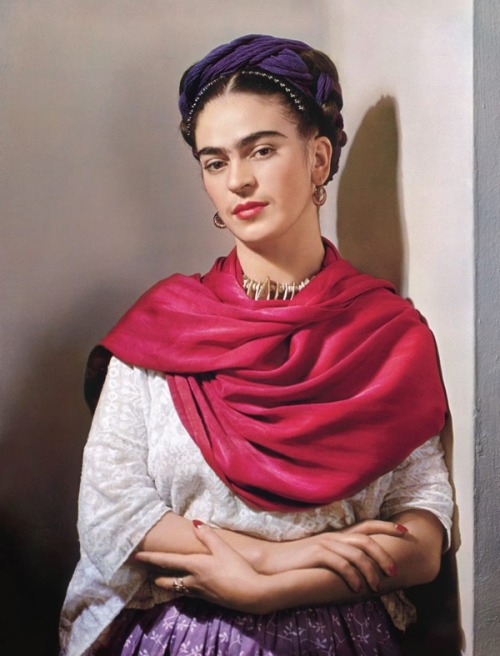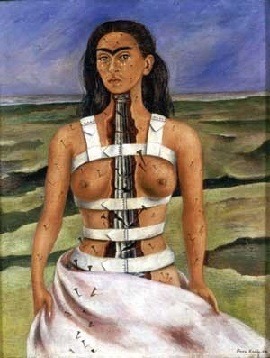Fate gave Frida Kahlo a transfixing beauty and a lifetime of suffering, both physical and emotional. Over her life, she developed a distinctive personal style that accommodated all of her providential fortune, both assets and liabilities.
Frida contracted polio at the age of six, which left her left leg shorter than her right. At the age of 18, she suffered near-fatal injuries in a bus accident. These injuries would trouble her for the rest of her life. Most of her paintings are self-portraits, perhaps partly driven by the medical necessity of constant self-examination - testing this limb or that for mobility, pain. Or it could be that she looked around and found that the most beautiful and evocative object she saw was in her own mirror. Both of these aspects of her self-appraisal can be found in her self-portraits - sometimes she sees herself as a patient, sometimes a talisman.
Her clothing, like her art, reflected this dichotomy of power and frailty.
Frida usually dressed in the traditional Tehuana style of Oaxaca, where her mother was born. One of the elements of this dress is a bright, embroidered tunic-like garment called a huipil. Here is one from her collection:

For Frida, this dress was an expression of nationalistic power. She was active within the Mexican Communist Party; she and her husband Diego Rivera even hosted Leon Trotsky at their home in Mexico after his split with Stalin and exile from the Soviet Union. She sometimes even combined symbols of communism with her Tehuana dress, as in this photograph:

Many famous images of Frida Kahlo capture her as a defiant beauty, maybe even similar to how Americans view the Statue of Liberty or how the French view Marianne. Certainly she caused a sensation in every room she entered.

But the huipil served another purpose as well: it hid her weakness. As a result of the bus accident, she often had to wear a corset to help support her spine. The huipil fits loose on the torso, hiding the corset underneath. Another element of Tehuana dress is the long skirt called an enagua, which you can also see in the first photo above. This long skirt hid the unevenness of Frida’s legs.
As she got older, Frida became less protective of her own weaknesses. In 1944, after spinal surgery, she painted The Broken Column, which hides nothing:

As her body continued to deteriorate, she seemed to detach from it entirely. In 1953, a year before her death, her right leg was amputated at the knee. This prompted her famous quote, “Feet, what do I want them for when I can fly?” After a lifetime of obsession with her own body and appearance, an obsession shared by many others besides herself, Frida Kahlo achieved transubstantiation. It’s Portrait of Dorian Gray in reverse - her art began as a reflection and contemplation of her body. As her body withered, her art flourished and endured, gaining new powers. Even the power of flight.